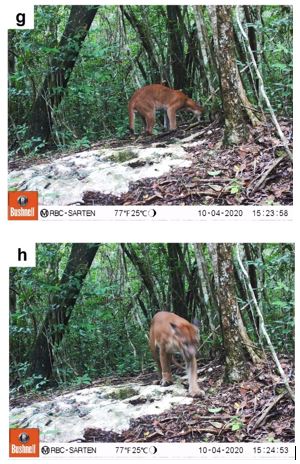Abstract
Scent marking through urine, glands, or the fur itself is an integral aspect of communication for many species, in this note we recorded through the use of camera traps within the Calakmul Biosphere Reserve, Mexico, that Didelphis marsupialis and Dasyprocta punctata are rubbed on Puma concolor scratchers to acquire the scent of the predator. This photographic record shows that the two prey species seek to capture the scent of the Puma, which could represent survival advantages by camouflaging its scent which represents an advantage against possible predators that occupy the same habitat.
References
Allen ML, Gunther MS, Wilmers CC. 2017. The scent of your enemy is my friend? The acquisition of large carnivore scent by a smaller carnivore. Journal of Ethology, 35(1), 13-19. https://doi.org/10.1007/s10164-016-0492-6
Allen ML, Wittmer HU, Houghtaling P, Smith J, Elbroch LM, Wilmers CC. 2015. The role of scent marking in mate selection by female Pumas (Puma concolor). PLoS One, 10(10), e0139087. https://doi.org/10.1371/journal.pone.0139087
Allen ML, Wittmer HU, Setiawan E, Jaffe S, Marshall AJ. 2016. Scent marking in Sunda clouded leopards (Neofelis diardi): novel observations close a key gap in understanding felid communication behaviours. Scientific reports, 6(1), 1-9. https://doi.org/10.1038/srep35433
Apfelbach R, Blanchard CD, Blanchard RJ, Hayes RA, McGregor IS. 2005. The effects of predator odors in mammalian prey species: a review of field and laboratory studies. Neuroscience & Biobehavioral Reviews 29:1123–1144. https://doi.org/10.1016/j.neubiorev.2005.05.005
Apps P, Rafiq K, McNutt JW.2019. Do carnivores have a world wide web of interspecific scent signals? In Chemical signals in vertebrates 14 (pp. 182-202). Springer, Cham. https://doi.org/10.1007/978-3-030-17616-7_14
Arakawa, H, Blanchard DC, Arakawa K, Dunlap C, Blanchard RJ .2008. Scent marking behavior as an odorant communication in mice. Neuroscience & Biobehavioral Reviews, 32(7), 1236-1248. https://doi.org/10.1016/j.neubiorev.2008.05.012
Bytheway JP, Carthey AJR, Banks PB.2013. Risk vs. reward: how predators and prey respond to aging olfactory cues. Behavioral Ecology and Sociobiology 67:715–725. https://doi.org/10.1007/s00265-013-1494-9
Contreras-Moreno F, Simá-Pantí DE, Cruz-Romo L, Petrone S, Méndez-Saint G, Méndez-Tun J, Jesús-Espinosa, Cruz-Molina I, Coutiño C, Duque V (2022). Registros destacados de Spilogale angustifrons en la Reserva de la Biosfera Calakmul. Revista Colombiana de Ciencia Animal-RECIA, 14(1), e913-e913. https://doi.org/10.24188/recia.v14.n1.2022.913
Delgado C, Mendoza E.2020. La importancia de las sartenejas como fuente de agua para la fauna silvestre en la región de Calakmul, Campeche. Biodiversitas, 151:1-6.
Delgado-Martínez CM, Alvarado F, Mendoza E, Flores-Hernández S, Navarrete A, Navarrete E, Botello F. 2018. An ignored role of sartenejas to mitigate water shortage hazards for tropical forest vertebrates. Ecology 99(3): 758-760. https://www.jstor.org/stable/26624193
García-Gil, G, Pat J. 2001. Apropiación del espacio y colonización de la selva en la Reserva de la Biosfera Calakmul, Campeche. Revista Méxicana del Caribe, 10:212-231.
García-Gil G, Palacio J, Ortiz M. 2002. Reconocimiento geomorfológico e hidrográfico de la Reserva de la Biosfera Calakmul, México. Investigaciones Geográficas 48:7-23.
King SRB, Gurnell J.2007. Scent-marking behaviour by stallions: an assessment of function in a reintroduced population of Przewalski horses (Equus ferus przewalskii). Journal of Zoology 272:30–36. https://doi.org/10.1111/j.1469-7998.2006.00243.x
Li J, Schaller GB, McCarthy TM, Wang D, Jiagong Z, Cai P, Basang L, Lu Z. 2013. A communal signpost of snow leopards (Panthera uncia) and other species on the Tibetan Plateau, China. Int J Biodivers 2013:370905. https://doi.org/10.1155/2013/370905
Long RA, Donovan T M, Mackay P, Zielinski WJ, Buzas JS (2007). Effectiveness of scat detection dogs for detecting forest carnivores. The Journal of Wildlife Management, 71(6): 2007-2017. https://doi.org/10.2193/2006-230
Martínez E, Galindo-Leal C. 2002. La vegetación de Calakmul, Campeche, México: clasificación, descripción y distribución. Boletín de la Sociedad Botánica de México, 71: 7-32.
Nie Y, Swaisgood RR, Zhang Z, Hu Y, Ma Y, Wei F. 2012. Giant panda scent-marking strategies in the wild: role of season, sex and marking surface. Animal Behaviour, 84(1), 39-44. https://doi.org/10.1016/j.anbehav.2012.03.026
Pacheco R, Cáceres-Martínez CH, Acevedo A, Arias-Alzate A, González-Maya JF. 2018. Food habits of Puma (Puma concolor) in the Andean areas and the buffer zone of the Tamá National Natural Park, Colombia. Therya, 9(3), 201-208.
Pembury MQ, Ruxton GD. 2020. Camouflage in predators. Biological Reviews, 95(5), 1325-1340. https://doi.org/10.1111/brv.12612
Piñeiro A, Barja I. 2015. Evaluating the function of wildcat faecal marks in relation to the defence of favourable hunting areas. Ethology Ecology & Evolution, 27(2), 161-172. https://doi.org/10.1080/03949370.2014.905499
Rau, JR, Jiménez JE. 2002. Diet of Puma (Puma concolor, Carnivora: Felidae) in coastal and Andean ranges of southern Chile. Studies on Neotropical fauna and environment, 37(3), 201-205.
Rostain R, Ben-David M, Groves P, Randall JA. 2004. Why do river otters scent-mark? An experimental testof several hypotheses. Animal Behaviour 68, 703–711. https://doi.org/10.1016/j.anbehav.2003.10.027
Taber AB, Novaro AJ, Neris N, Colman FH. 1997. The food habits of sympatric jaguar and Puma in the Paraguayan Chaco. Biotropica, 29(2), 204-213. https://doi.org/10.1111/j.1744-7429.1997.tb00025.x
Zhou W, Nie Y, Swaisgood RR, Li Y, Liu D, Wei F. 2019. Ecological context influences scent‐marking behavior in the giant panda. Journal of Zoology, 309(3), 191-199. https://doi.org/10.1111/jzo.12711

This work is licensed under a Creative Commons Attribution 4.0 International License.






